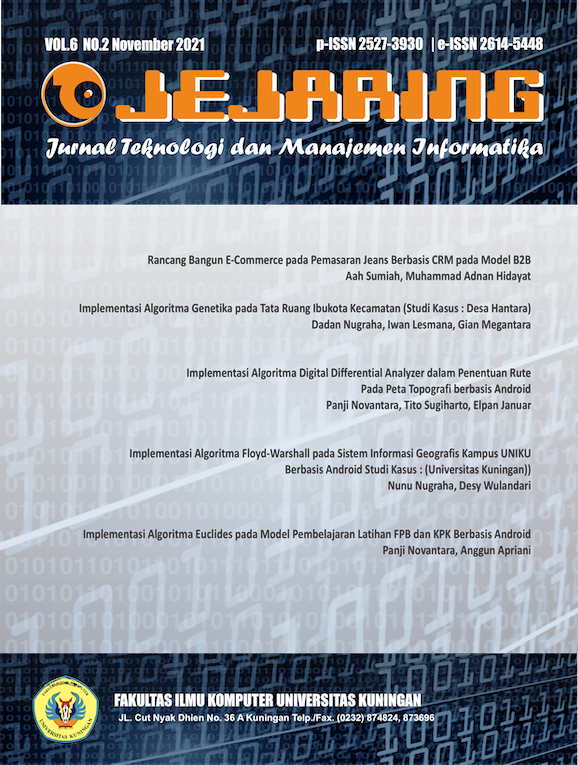Implementasi Algoritma Genetika pada Tata Ruang Ibukota Kecamatan (Studi Kasus : Desa Hantara)
Abstract
Spatial planning is an obligation that must be carried out by each Regional Government. At present, spatial planning is still conventionally planned by the spatial planning company. Regarding with the object of research that the authors examined, namely Hantara Village, Hantara Village did not yet have a plan for how the future projection and development of Hantara Village. With a touch of information technology, for now spatial planning can be done using an application by implementing a method that is Genetic Algorithm into the application .Genetic Algorithm is an optimal search algorithm which is in its implementation the genetic algorithm will look for the most optimal points which is match with the constraints that have been determined based on law 26 of 2007 concerning Spatial Planning. Then the search results of the genetic algorithm data will be visualized by using the features of the mapbox, the online map provider. In software development, the author use the Rational Unified Process (RUP) method which has four stages, namely: Inception, Elaboration, Contruction, and Transition. This application is built use the python programming language, along with html and javascript for visualizing the data. Based on the results of this research the authors can conclude that this research can make a projection of residental area in Hantara village accordance with genetic algorithm and its constraint.
Keywords— Sepatial Planning, Genetic Algorithm, Data Visualization, RUP, Python
References
. Badan Pengelola Statistik. (2018).
Kecamatan Hantara Dalam Angka
, Kuningan : CV.Setya Mandiri
Jaya
. Pemerintah Desa Hantara. (2017).
Profil Desa Hantara, Hantara : tidak
dipublikasikan.
. Lesmana, I. (2014). Penjadwalan
Perkuliahan Dengan Menggunakan
Algoritma Genetika. Tesis Magister
pada Program Studi Ilmu Komputer
Institut Pertanian Bogor : Bogor.
. Purwanto, F., Djamal, E. C. dan
Komarudin, A. (2016), “Optimalisasi
Penempatan Halte Trans Metro
Bandung Menggunakan Algoritma
Genetika”. Seminar Nasional Aplikasi
Teknologi Informasi. 6 Agustus: B-36-
. Saputro, H. A., Mahmudy, W. F., dan
Dewi C. (2015), Implementasi
Algoritma Genetika Untuk Optimasi
Penggunaan Lahan Pertanian. Jurnal
Mahasiswa PTIIK Universitas
Brawijaya, 5(12)
. Sukamto, R.A., dan Shalahuddin, M.
(2018). Rekayasa Perangkat Lunak
(Terstruktur dan Berorientasi Objek).
Edisi Revisi. Bandung : Informatika
. Smith, K, S et.al. (2002). State and
Local Projection. New York: Kluwer
Academic Publisher
. BKKBN (2018). Jumlah Kepala
Keluarga dan Jumlah Jiwa dalam
Keluarga Menurut Jenis Kelamin
Berdasarkan Tahapan [Online].
Tersedia:
http://aplikasi.bkkbn.go.id/mdk/MDK
Reports/Kependudukan/Tabel55.aspx
September 2018]
. Suyanto. (2005). Algoritma Genetika
dalam Matlab. Edisi 1. Yogyakarta :
Andi Publisher
. Zukhri, Z. (2014). Algoritma Genetika.
Edisi 1. Yogyakarta : Andi Publisher
. Syarief, A. (2014). Algoritma Genetika
Teori dan Aplikasi. Edisi 2.
Yogyakarta:Graha Ilmu
. Republik Indonesia. 2007. Undang-
Undang No. 26 Tahun 2007 tentang
Penataan Ruang. Lembaran Negara RI
Tahun 2007. Sekretariat Negara.
Jakarta.
Penulis yang menerbitkan jurnal ini menyetujui persyaratan berikut:
Hak cipta untuk artikel ini ditransfer ke JEJARING jika dan ketika artikel diterima untuk publikasi. Yang bertanda tangan di bawah ini dengan ini memindahkan setiap dan semua hak di dalam dan ke kertas termasuk tanpa batasan semua hak cipta untuk JEJARING. Yang bertanda tangan di bawah ini dengan ini menyatakan dan menjamin bahwa makalah tersebut asli dan bahwa ia adalah pembuat makalah, kecuali untuk materi yang secara jelas diidentifikasi sebagai sumber aslinya, dengan pemberitahuan izin dari pemilik hak cipta jika diperlukan. Yang bertanda tangan di bawah ini menyatakan bahwa ia memiliki kekuatan dan wewenang untuk membuat dan melaksanakan tugas ini. Formulir transfer hak cipta akan dikirim melalui email sebelum artikel dipublikasikan.
Penulis yang sesuai menandatangani dan menerima tanggung jawab untuk merilis materi ini atas nama setiap dan semua penulis bersama. Perjanjian ini harus ditandatangani oleh setidaknya salah satu penulis yang telah memperoleh persetujuan dari rekan penulis jika berlaku. Setelah pengajuan perjanjian ini ditandatangani oleh penulis yang bersangkutan, perubahan kepengarangan atau dalam urutan penulis yang tercantum tidak akan diterima.

